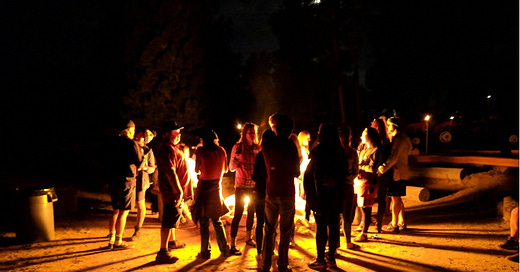Photo by wes lewis on Unsplash
In the industrial revolution, the drive for efficiencies created some very unattractive working conditions and poor remuneration. These were the workplaces William Blake described as ‘dark satanic mills’ and around which Marx and Engels developed their philosophy. Charles Dickens vividly portrayed the working conditions prevalent in Victorian England, particularly the exploitation of children in factories and the harsh realities of the workhouse where the balance of power was all one way. Christian business philanthropists sought to change this dark picture, but they were a minority and even they had blind spots.
Many factors since then have improved this workplace power balance, most obviously the trade union movement that gave front line workers a voice by championing better working conditions and campaigning for fair remuneration. The solidarity of collective representation created positions of strength and the leverage from which to negotiate. And there have been many other rebalancing forces in this tug of war.
For instance, rethinking corporate governance has led to employee directors having a voice in the board room (see here). Politicians have introduced legislation that must be respected by international trading partners, while customers have exercised their purchasing power when they disapprove of company behaviour. The impact of boycotts and ethical investors have put pressure on businesses to respect specific values, which may embrace the way employees are treated.
Chief executives have attempted to create corporate cultures that recognise employees as humans and not just assets or resources. All these forces for change and better representation can and should have a positive impact on the workplace. Why then do so many workplaces still feel so toxic? The problem is that, like any good medicine, there are side effects.
Here's a reflection from the engineering industry in the early 1970’s:
It was in the drawing office that I met with some difficult encounters with trade union practices. Because I was enjoying my job, I worked steadily through the day without realising that I was probably exceeding the average daily output of my colleagues. It all became clear when, on returning from a comfort break, I found my pencils symbolically broken in half. I did my best to slow down but evidently not enough because the next signal was a cup of coffee “accidentally” spilt over a drawing I had been working on for a couple of days. They had made their point, and I understood. I didn’t enjoy being punished for the crime of enjoying what I was doing. I struggled to equate these collective behaviours with people who I knew to be thoroughly decent individuals.
On another occasion the works convener called a factory strike at a moment when the sales team were attempting to complete a major proposal that would create work for the factory for several years ahead. The submission needed some input from my team. To ensure we weren’t going to miss the submission deadline; I knowingly crossed the picket line to assist with the proposal. We did complete the proposal on time, and we did win the business. I was delighted until the Manufacturing Director, explained to me that the trade union had complained and that, to keep the peace, I had to take a day off without pay as my reward.
This is not an anti-union post. Our attitudes to trades union are mixed, and we have explored toxicity from top (see here) and middle management (see here). We simply note that achieving sufficient solidarity to bargain effectively can both improve and damage the workplace experience at the same time, and that reprisals against dissenters may leave lasting divisions in their wake.
The BBC crime drama, Sherwood, is set in 2004 in a Nottinghamshire mining village. Two shocking killings shatter an already fractured community with a dark past arising from divisions originating from the 1984 miners’ strike. The story is loosely based on the actual murders of trade unionist Keith Frogson and hairdresser Chanel Taylor and the deep scars persisted for decades.
We have already observed (see here) that chief executives can be driven by dubious ethics and in a future post we will explore the unavoidable influence of major investors. We have also noted how middle managers can borrow behaviour when they go into the workplace that they wouldn’t adopt outside (see here). Building on this, we see that workers, too, can treat each other at work in ways they would not treat a neighbour. Clearly, this is a chart in the making and we plan to develop it in conjunction with a simple model of loyalty at work – who deserves it most and who gets it most.
For now, we note that both senior management and workers often behave toxically at work because of pressures to compete or conform. Clearly, there is a knock-on effect into corporate culture to which both tribes contribute and from which both tribes take their cue.
As we have noted (see here), where views across the table differ, business is at the mercy of which ever voice wins out. The toxicity or otherwise of the workplace is the sum of these struggles for supremacy in what is said and done. In other words, the workplace is also the victim of the struggle itself.
We will examine this picture of borrowed behaviours more, especially to understand firstly the uncharacteristic behaviours that individuals put on from the business wardrobe and then wear to work. Next, we need to find a simple way to connect the various sources and drainage points. As we are beginning to see, individuals, either in their own right or as part of a cohort, may both contribute to and exhibit characteristics at work that they do not reflect elsewhere. Finally, we must then see how such behaviour adversely impacts the workplace. The key question will be how to break out if this vicious toxic circle.
The emerging picture is that there is no single toxic inlet in business: it may may drain in from the top, well up from the bottom, permeate from outside or percolate from the middle.
Also in the Oppressive Workplace series:
The oppressive workplace: compass glitches (1 May 2025)
The oppressive workplace: sharp elbows ( 8 May 2025)
The oppressive workplace: herd instinct (15 May 2025)







